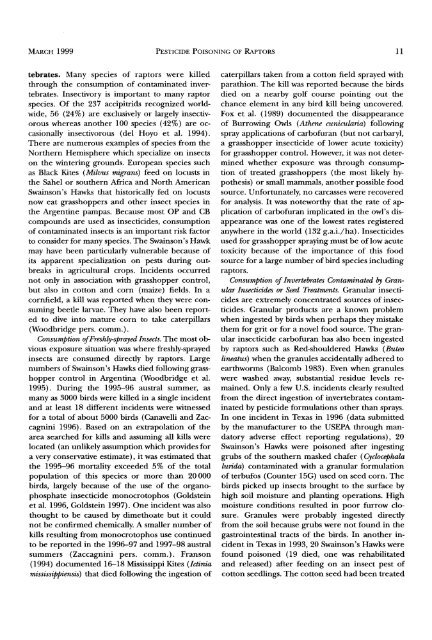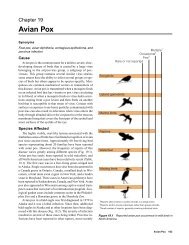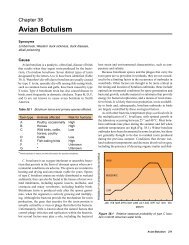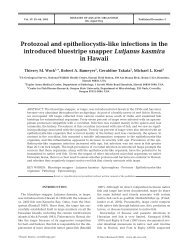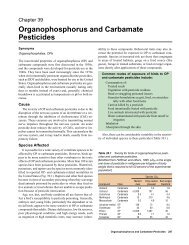poisoning of raptors with organophosphorus and carbamate ...
poisoning of raptors with organophosphorus and carbamate ...
poisoning of raptors with organophosphorus and carbamate ...
Create successful ePaper yourself
Turn your PDF publications into a flip-book with our unique Google optimized e-Paper software.
iYLM/CH 1999 PESTICIDE POISONING OF RAPTORS 11<br />
tebrates. Many species <strong>of</strong> <strong>raptors</strong> were killed<br />
through the consumption <strong>of</strong> contaminated invertebrates.<br />
Insectivory is important to many raptor<br />
species. Of the 237 accipitrids recognized worldwide,<br />
56 (24%) are exclusively or largely insectivorous<br />
whereas another 100 species (42%) are occasionally<br />
insectivorous (del Hoyo et al. 1994).<br />
There are numerous examples <strong>of</strong> species from the<br />
Northern Hemisphere which specialize on insects<br />
on the wintering grounds. European species such<br />
as Black Kites (Milvus migrans) feed on locusts in<br />
the Sahel or southern Africa <strong>and</strong> North American<br />
mined whether exposure was through consumption<br />
<strong>of</strong> treated grasshoppers (the most likely hypothesis)<br />
or small mammals, another possible food<br />
Swainson's Hawks that historically fed on locusts source. Unfortunately, no carcasses were recovered<br />
now eat grasshoppers <strong>and</strong> other insect species in<br />
the Argentine pampas. Because most OP <strong>and</strong> CB<br />
compounds are used as insecticides, consumption<br />
<strong>of</strong> contaminated insects is an important risk factor<br />
to consider for many species. The Swainson's Hawk<br />
may have been particularly vulnerable because <strong>of</strong><br />
its apparent specialization on pests during outbreaks<br />
in agricultural crops. Incidents occurred<br />
not only in association <strong>with</strong> grasshopper control,<br />
for analysis. It was noteworthy that the rate <strong>of</strong> application<br />
<strong>of</strong> carb<strong>of</strong>uran implicated in the owl's disappearance<br />
was one <strong>of</strong> the lowest rates registered<br />
anywhere in the world (132 g.a.i./ha). Insecticides<br />
used for grasshopper spraying must be <strong>of</strong> low acute<br />
toxicity because <strong>of</strong> the importance <strong>of</strong> this food<br />
source for a large number <strong>of</strong> bird species including<br />
<strong>raptors</strong>.<br />
Consumption <strong>of</strong> Invertebrates Contaminated by Granbut<br />
also in cotton <strong>and</strong> corn (maize) fields. In a<br />
cornfield, a kill was reported when they were consuming<br />
beetle larvae. They have also been reported<br />
to dive into mature corn to take caterpillars<br />
(Woodbridge pers. comm.).<br />
Consumption <strong>of</strong> Freshly-sprayed Insects. The most obvious<br />
exposure situation was where freshly-sprayed<br />
insects are consumed directly by <strong>raptors</strong>. Large<br />
numbers <strong>of</strong> Swainson's Hawks died following grasshopper<br />
control in Argentina (Woodbridge et al.<br />
1995). During the 1995-96 austral summer, as<br />
many as 3000 birds were killed in a single incident<br />
ular Insecticides or Seed Treatments. Granular insecti<strong>and</strong><br />
at least 18 different incidents were witnessed<br />
for a total <strong>of</strong> about 5000 birds (Canavelli <strong>and</strong> Zaccagnini<br />
1996). Based on an extrapolation <strong>of</strong> the<br />
area searched for kills <strong>and</strong> assuming all kills were<br />
located (an unlikely assumption which provides for<br />
a very conservativ estimate), it was estimated that<br />
the 1995-96 mortality exceeded 5% <strong>of</strong> the total<br />
population <strong>of</strong> this species or more than 20000<br />
birds, largely because <strong>of</strong> the use <strong>of</strong> the organophosphate<br />
insecticide monocrotophos (Goldstein<br />
et al. 1996, Goldstein 1997). One incident was also<br />
thought to be caused by dimethoate but it could<br />
not be confirmed chemically. A smaller number <strong>of</strong><br />
kills resulting from monocrotophos use continued<br />
to be reported in the 1996-97 <strong>and</strong> 1997-98 austral<br />
summers (Zaccagnini pers. comm.). Franson<br />
(1994) documented 16-18 Mississippi Kites (Ictinia<br />
mississippiensis) that died following the ingestion <strong>of</strong><br />
caterpillars taken from a cotton field sprayed <strong>with</strong><br />
parathion. The kill was reported because the birds<br />
died on a nearby golf course pointing out the<br />
chance element in any bird kill being uncovered.<br />
Fox et al. (1989) documented the disappearance<br />
<strong>of</strong> Burrowing Owls (Athene cunicularia) following<br />
spray applications <strong>of</strong> carb<strong>of</strong>uran (but not carbaryl,<br />
a grasshopper insecticide <strong>of</strong> lower acute toxicity)<br />
for grasshopper control. However, it was not deter-<br />
cides are extremely concentrated sources <strong>of</strong> insecticides.<br />
Granular products are a known problem<br />
when ingested by birds when perhaps they mistake<br />
them for grit or for a novel food source. The granular<br />
insecticide carb<strong>of</strong>uran has also been ingested<br />
by <strong>raptors</strong> such as Red-shouldered Hawks (Buteo<br />
lineatus) when the granules accidentally adhered to<br />
earthworms (Balcomb 1983). Even when granules<br />
were washed away, substantial residue levels remained.<br />
Only a few U.S. incidents clearly resulted<br />
from the direct ingestion <strong>of</strong> invertebrates contaminated<br />
by pesticide formulations other than sprays.<br />
In one incident in Texas in 1996 (data submitted<br />
by the manufacturer to the USEPA through m<strong>and</strong>atory<br />
adverse effect reporting regulations), 20<br />
Swainson's Hawks were poisoned after ingesting<br />
grubs <strong>of</strong> the southern masked chafer (Cycl0cephala<br />
lurida) contaminated <strong>with</strong> a granular formulation<br />
<strong>of</strong> terbufos (Counter 15G) used on seed corn. The<br />
birds picked up insects brought to the surface by<br />
high soil moisture <strong>and</strong> planting operations. High<br />
moisture conditions resulted in poor furrow closure.<br />
Granules were probably ingested directly<br />
from the soil because grubs were not found in the<br />
gastrointestinal tracts <strong>of</strong> the birds. In another incident<br />
in Texas in 1993, 20 Swainson's Hawks were<br />
found poisoned (19 died, one was rehabilitated<br />
<strong>and</strong> released) after feeding on an insect pest <strong>of</strong><br />
cotton seedlings. The cotton seed had been treated


